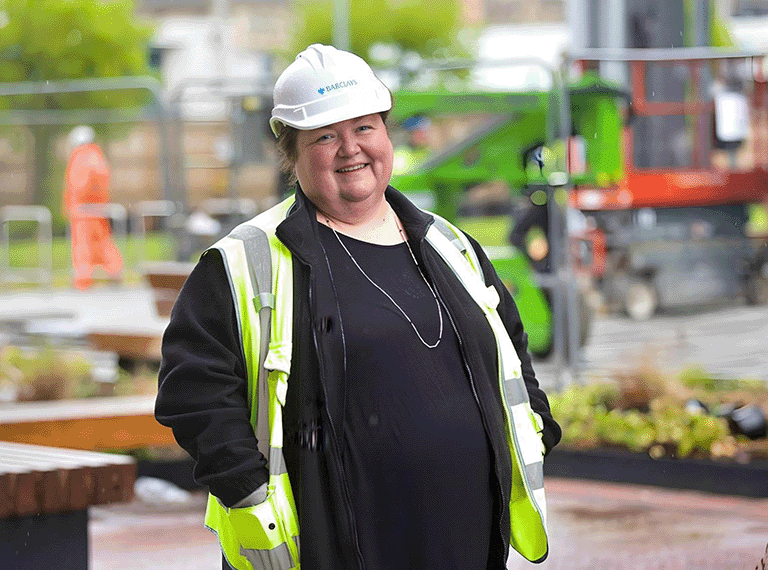With adjustable lighting, quiet and sensory rooms just some of the features of its new Glasgow campus, Barclays have gone above and beyond to show its neurodivergent employees it cares about their comfort and wellbeing and will accommodate them to work at their best.
Neurodivergent employees - those with autism, ADHD, dyslexia, dyspraxia and other conditions outside the neurotypical norm - often require reasonable adjustments to be made for them to thrive in the workplace. Barclays is one of the first major organisations to provide an environment built with the needs of neurodivergent people in mind.
The campus and team behind its development has since won a multitude of sustainability, HR, and other awards, including HR Network Best Employer/Workplace of the Year 2022, Property Week Awards – Health and Wellbeing Initiative Award, and BCO – Best of the Best 2023.
We asked Ron Coghill, Managing Director, Head of Capital Projects and Workplace, Barclays, all about the project and for her advice to employers on building workplaces with neurodiversity in mind.
Q: What makes the Barclays Glasgow campus neuroinclusive?
A: We really took a holistic view of the campus, from the lighting and sound environment to the colours, textures, signage, fire escapes, and the accessibility of the doors and toilets. Every aspect of the overall design was reviewed through the lens of inclusion – not just neuroinclusion. For instance, there’s Braille and contactless features throughout the campus, to aid those with impaired mobility or vision.
Many neurodivergent people have sensory issues, such as hypersensitivity to light, sound, and textures. Throughout the campus, we considered the textures and artworks we used in each space. Employees who have issues with lighting can book specific desks with softer lighting. We also have quiet rooms with acoustic padding, plain walls and individual temperature control – these can also be booked or used as and when required.
There are velvet booths, biophilic (natural) elements, tactile and soft furniture and walls, meeting/training rooms with walls of stone or wood, and even swings to help with proprioceptive (body awareness) and vestibular (balance) regulation. These can help neurodivergent people to drown out external stimuli, which can be overwhelming, and to regulate their senses, feeling more comfortable and focused as a result.
Every toilet facility at the campus has also been reviewed to ensure each one is touch-free and accessible. For those sensitive to noise, we have cubicles with low noise emission hand driers, and paper towels. We also have Changing Places facilities, for people who need help using the toilet, and there are gender-neutral toilets on every floor.
Q: Where did the idea to make the Glasgow offices neuroinclusive come from?
A: At the very outset of Barclays making this investment was a commitment to considerable investment in Glasgow. And part of this was to drive access to job roles for people who had usual obstacles to employment – so people with physical disabilities, hidden disabilities such as neurodiversity, and those from economically disadvantaged backgrounds.
The project was one very close to my heart, because my son is autistic. He has an autism diagnosis and needs significant additional support. I wanted to build a space that my son could work in one day. My personal experience, combined with my background in architecture, and the fact that I’ve worked on disability access before, made this an exciting challenge.
However, to ensure we got the neurodiversity aspect of the project right, to be able to question what we were doing and bring in that different lens, we brought in Scottish Autism as partners. They were one of the first companies on board, and it was incredibly helpful to have them guiding us through the complex decisions we were making around neuroinclusive design. There isn’t a handbook for that because it’s not one-size-fits-all, but there was a very clear corporate goal and objective.
Q: How did you come up with the designs for the inclusive elements of the building?
A: Barclays, like most corporates, has a guidebook from which we take the best learnings from the last project, we update it, and build on it. I’m responsible for that globally. We ensure that 20% of any scheme is local to the area that it’s in and the other 80% is reviewed against every diversity, inclusion, and neurodiverse design standard we had.
We reviewed all the barriers people might have to working in a space. We’ve got a huge, wonderfully diverse colleague base in Glasgow. It’s probably one of the most diverse campuses we’ve got anywhere.
It was an inclusive process from the start. We tried to pull in as many employee relation groups as we have in Barclays. We consulted each group on the areas that we thought they would be sensitive about from toilet design to multi-faith provision, and also things like food provision (taking into consideration kosher and halal options). It was crucial for us to listen to the end users in the buildings. This was during Covid, though, which made it quite challenging to engage people. But, because it was such a positive thing, once we got their attention, we got more than enough feedback.
Q: What are the benefits that you’ve seen from the design of the building? Have you had any feedback from neurodivergent staff?
A: The feedback across all staff groupings has been extremely positive. We’ve gone directly to our neurodiversity working group and followed up with them, and their feedback was really good – the staff are very comfortable. We’ve had instances where staff that hadn't previously disclosed they were autistic, or getting a diagnosis, have now joined some of these working groups and are really comfortable to talk about things that perhaps three or four years ago they wouldn’t have been. I think that’s because Barclays has been so open about wanting to be inclusive of everyone, including those on the spectrum.
The best teams are those that are diverse, both culturally and in terms of disability and inclusivity – walking around the Glasgow office is great because it’s so diverse. I like to sit in the open plan office and listen to the first-hand feedback and it’s been excellent so far. Obviously, we’ve won lots of awards – I’ve stopped counting now, which is great. And a lot of that is around innovation for inclusive design, ESG, HR etc.
The only issue now seems to be that we don’t have the same solution we’ve got in Glasgow deployed everywhere in the world. Barclays employees across the business want to know when they can have the same. The truth is that it will come over time. We’ve set the bar pretty high and now we’re trying to raise it in other locations.
Having said that, if I were to do it all again, there’s a couple of things I would have done differently. Technology has changed a bit, even in the last two or three years since we finished the design of the buildings. There’s one cool piece of technology around hearing loops that’s just coming to the market now and we could’ve run that over our networks.
Q: Was it expensive to build for neuroinclusion? It is something that would be beneficial for every company?
A: It’s a rule of thumb in construction that it’s about a thousand times more expensive to go back in and retrofit something than it is to do it right the first time. I would say it didn’t cost anything more for us to design for inclusion from the beginning. It was such a normal amount we never managed to define it. However, if we’d had to go back in and retrofit it, it would’ve been more like 10% of the total project cost. It’s much more expensive and harder to gather the data and come back to it.
We were lucky to be building out of the ground because we were able to specify from day one that there were to be no barriers, or thresholds, and everything would adhere to the Equality Act (2010). I used to be in a wheelchair, so I know how it feels to face barriers getting in and out of a building. Inclusive design is just about good design. It’s just about being a little bit more sensitive and not rolling out the same solution across everything. We knew what we were looking for, we set the objectives, and inclusion was part of the plan from day one.
Q: What can other employers do to ensure they're making their working environment neuroinclusive?
A: As you walk through Barclays buildings, there is no sign that says: “This space is designed to be neuroinclusive”. It's all about giving people choices and allowing people to self-select. That’s the most important thing – making sure you’re providing flexibility and not labelling anything as ‘neuroinclusive’.
People will naturally select the environment that works better for them. We have two types of meeting rooms. One type has very busy wallpaper and carpet – which works for people who want to get their energy up or if it matches their personalities. The other has neutral walls and acoustic padding and panelling. We’ve found that those quieter spaces are popular with a bunch of staff, not just people that I know are on the spectrum.
The lighting design is something I think we did really well but, again, could’ve done even better. Some neurodivergent people are hypersensitive to light, including my son. We made the blocks of lighting changeable in modules of 12 for those who might want a lower light level in a specific area. But, even then, there are six desks to every module of 12, which means that area is probably still too big. We probably should've taken it down to individual lighting. It’s just about allowing people to constantly self-select and giving them enough environments to feel comfortable in.
Q: What advice would you give on designing an inclusive working environment?
A: My advice would be to consider neuroinclusive design from the start: listen to your staff, your colleagues and, if you can, bring in external experts. There are companies in the market that will provide that kind of support. Don't assume you know, because some member of staff will always come up with something you've never thought about – make sure you’re including their voice – and do that from day one.
If you’re looking for a talented professional to build your neurodiverse workforce or find a new opportunity, contact your nearest Reed office today.




